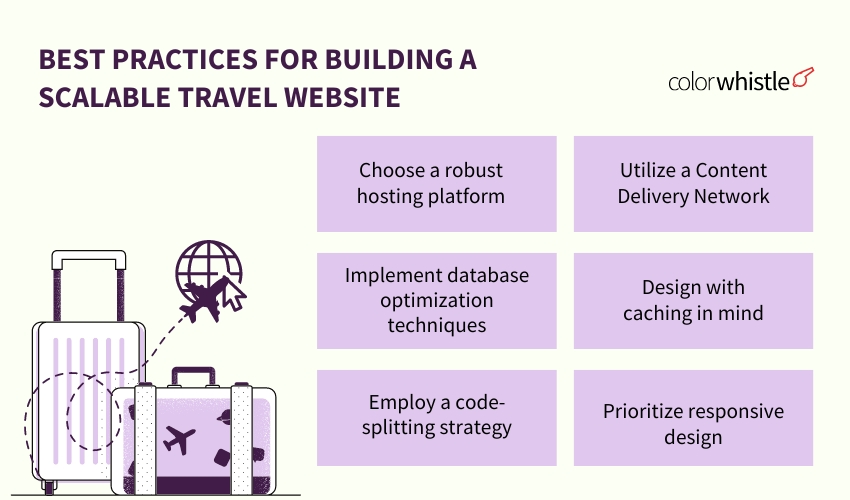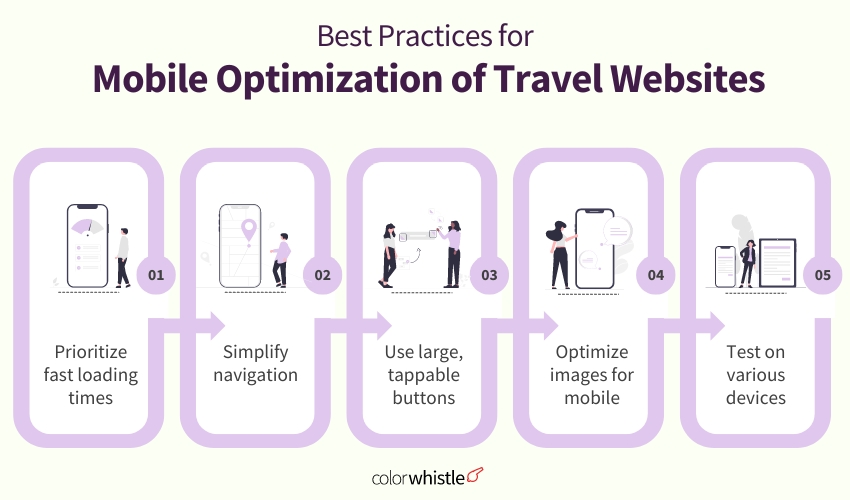In today’s fast-moving, digitally-focused world, the travel sector is changing significantly. With billions of people using smartphones and tablets, the demand for a mobile-friendly travel website that supports smooth, on-the-go planning has never been greater. A travel website that isn’t mobile-friendly and able to handle spikes in traffic is like a travel agency without a guide highlighting the importance of scalable travel solutions.
Building a mobile-friendly travel website comes with its fair share of obstacles. From selecting the best technology stack to enhancing speed and performance, and guaranteeing a smooth user experience on all devices, the journey is not without challenges. This is where website design services come into play, ensuring that travel platforms offer an exceptional user experience and meet the expectations of modern travelers.
Consider partnering with a website design company to leverage their expertise in crafting visually stunning, high-performing travel websites that can withstand the demands of the industry.
Whether you’re a seasoned travel entrepreneur or just starting, this blog is your comprehensive guide to navigating these challenges and building a travel website that not only meets but exceeds your customers’ expectations with a mobile-friendly website design that supports scalability.
We’ll delve into the best practices, share actionable tips, and provide real-world examples to help you create a website that is not just functional but also a powerful tool for driving bookings and customer loyalty. Let’s get started.
Did You Know?
63% of Google searches occur on mobile in the U.S.
Understanding Scalability and Mobile-Friendly Design for Travel Websites
In the travel industry, scalability is crucial for websites to manage increased traffic and data volumes without sacrificing performance or user experience. This is especially important for travel businesses, as booking demands can vary greatly due to peak travel seasons, holidays, or unforeseen events. A scalable travel website design guarantees seamless performance during busy times, avoiding crashes and keeping customers happy. Also, check our blog on Custom WordPress Plugins and Websites to know about plugins to build a scalable website.
Also Read
Benefits of a Scalable, Optimized Travel Website for Business
Enhanced User Experience
With a website that can scale effectively, you can expect speedy load times and effortless navigation, even when there’s a surge in traffic. This will boost user satisfaction and drive up conversion rates.
Business Growth
Scalability enables travel companies to handle higher volumes of traffic and reservations without facing any technical difficulties. This creates opportunities for business development and greater income.
Competitive Advantage
To set themselves apart and increase their customer base, travel websites should focus on delivering a top-notch user experience that can easily grow with their business.
Cost Efficiency
Although the initial costs of investing in scalability may be higher, it can save money in the long term by preventing costly downtime and system failures.
Importance of Mobile Optimization for Travel Business Websites
As online searches and bookings increasingly occur on mobile devices, travel businesses can no longer afford to overlook the need for a mobile-friendly travel website. A mobile-friendly travel website provides numerous benefits:
- Increased bookings: An optimized mobile website is key to attracting more users who prefer browsing on their phones. With easy navigation and the ability to book travel directly on the site, this results in a significant increase in bookings compared to a website that is not optimized for mobile devices.
- Enhanced user experience: Mobile-friendly websites are created to adjust to smaller screens, allowing for easy reading and navigation through touch commands. This guarantees that users can access information and accomplish tasks smoothly, without any hassle or inconvenience.
- Improved search engine rankings: To improve search rankings, Google favors websites with a mobile-friendly design. Having a mobile-friendly site increases the chances of ranking higher in search results, which can help attract more customers to a travel business.
- Faster load times: Websites that load quickly keep visitors interested. Visitors tend to leave if a website loads slowly. Fast page load times motivate users to browse more, improving their chances of finding what they are looking for and possibly making a reservation.
- Better customer satisfaction: Travel businesses need to have websites that work well on mobile devices. This makes it easier for customers to plan their trips using their smartphones. Delighted customers are likely to come back for more and share their positive experiences with others.
Also Read
What Are The Best Practices for Building a Dynamic, Scalable Travel Website?

Below are some of the tips to improve the user experience and conversion rates for travel websites by building a scalable travel website.
- Choose a robust hosting platform: Choose a hosting provider that is renowned for its scalability and reliability to handle fluctuations in website traffic effectively.
- Utilize a Content Delivery Network (CDN): A content delivery network (CDN) spreads out website content among servers in different parts of the world, guaranteeing quick loading speeds for users worldwide.
- Implement database optimization techniques: Fine-tune database queries and structures to effectively manage large volumes of data and user demands.
- Design with caching in mind: Utilize browser caching to keep often-accessed information stored locally, decreasing the server’s workload for future visits.
- Employ a code-splitting strategy: Optimize your website’s performance by splitting the code into smaller, loadable modules to achieve faster loading times for the initial page.
- Prioritize responsive design: Make sure the website adjusts smoothly to various screen sizes and devices.
Did You Know?
61% of consumers say they are more likely to purchase from mobile-friendly sites
What Are the Best Practices for Mobile-Friendly Travel Website Optimization?
Best practices for designing a high-performing travel website start with optimizing for mobile devices. Some of the ways you can start is by,

- Prioritize fast loading times: For a faster mobile experience, optimize images, minimize redirects, and make use of browser caching.
- Simplify navigation: Make sure the menus on touchscreens are easy to understand, brief, and simple to move through.
- Use large, tappable buttons: Keep buttons and call-to-actions readily visible and easy to use on smaller displays.
- Optimize images for mobile: Optimize image file sizes to improve loading speed without compromising quality.
- Test on various devices: It’s important to consistently test your website on smartphones and tablets to detect and address any display issues.
Also Read
Wrapping Up
The foundation of success in today’s digital travel world lies in having a scalable and mobile-friendly travel website. This guide has equipped you with essential practices for building a website that not only functions flawlessly but also actively encourages bookings and fosters customer loyalty.
Keep in mind that the perfect travel website should empower users to seamlessly explore and book from any device. It’s time to take action and pave the way for your travel website’s triumph.
ColorWhistle offers seamless expert guidance on travel website design services, and ongoing support to ensure a smooth and successful implementation.
Feel free to drop by our ColorWhistle page, where you can uncover the full scoop on our top-notch travel website development solutions. If you need expert assistance send a message or give us a call at +1 (919) 234-5140, and we’ll promptly respond to your inquiry.
What’s Next?
Now that you’ve had the chance to explore our blog, it’s time to take the next step and see what opportunities await!







